Severn Tunnel
The Severn Tunnel (Welsh: Twnnel Hafren) is a railway tunnel under the Severn Estuary between England and Wales.
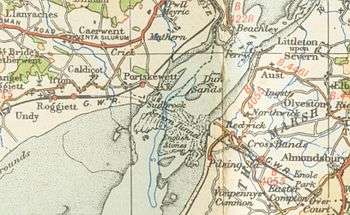
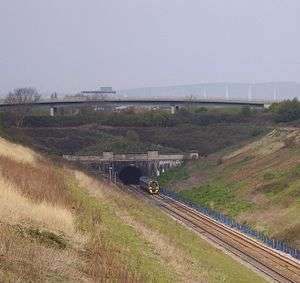
The tunnel links South Gloucestershire in the west of England to Monmouthshire in south Wales. It was constructed by the Great Western Railway (GWR) between 1873 and 1886 to shorten the journey between Western England and South Wales. Its completion has been regarded as the crowning achievement of the civil engineer Sir John Hawkshaw, the chief engineer of the GWR.[1]
Before the Severn Tunnel was built all traffic between Western England and South Wales was by ship or upriver via Gloucester. The single-track Severn Railway Bridge, 14 miles (22 km) upstream, opened during the construction of the tunnel. Recognising the value of a tunnel, the GWR tasked Hawkshaw with its design and the civil engineer Thomas A. Walker to undertake its construction, which commenced in March 1873. In October 1879, the works were flooded by what is now known as "The Great Spring". Through strenuous and innovative efforts, the flooding was contained and work continued, albeit with a great emphasis on drainage. Completed in 1885, the first passenger train was run through on 1 December 1886, nearly 14 years after the commencement of work.
The Severn Tunnel is a key element of the trunk railway line between southern England and South Wales. The GWR operated a Motorail service through the tunnel for many decades. The tunnel presents difficulties operationally and in the maintenance of its infrastructure. The 50 million litres of water per day that infiltrates the tunnel is removed using several large pumping engines. During the steam era, pilot and banking locomotives were required to assist heavy trains on the tunnel's challenging gradients.
The Severn Tunnel is 4 miles 624 yards (7,008 m) long, of which 2 1⁄4 miles (3.62 km) is under the river. It takes approximately 3 minutes 40 seconds for a train to travel through. The tunnel was the longest underwater tunnel in the world for more than 100 years until 1987 and it was the longest mainline railway tunnel in the UK until its length was exceeded in 2007 by the opening of the two London tunnels of High Speed 1, part of the Channel Tunnel Rail Link.[2] In late 2016, overhead line equipment was installed in the Severn Tunnel to allow electric traction to pass through as part of the 21st-century modernisation of the Great Western main line.
General
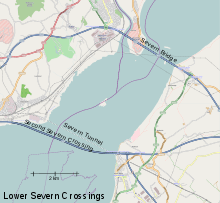
The Severn Tunnel is part of the trunk railway line between southern England and South Wales, and carries an intensive passenger train service and freight traffic. As of 2012, an average of 200 trains per day used the tunnel.[3] The line through the tunnel is controlled as a single signal section, which limits the headway of successive trains. The steep gradients (1 in 90 and 1 in 100) make working heavy freight trains difficult.[4]
A continuous drainage culvert between the tracks takes water to the tunnel's lowest point under Sudbrook Pumping Station, where it is pumped to the surface.[5] Should ignited petroleum run into the culvert in the event of derailment of a tank wagon, special arrangements are in place to prevent passenger trains entering while hazardous liquid loads are being worked through.[5]
At Sudbrook Pumping Station, an iron ladder descends in the shaft of the water pumping main and ventilation air is pumped in. The GWR ventilation arrangement was to extract air at Sudbrook, but the exhaust from steam trains caused premature corrosion of the fan mechanism. When the Cornish pumping engines were replaced in the 1960s, the draughting was reversed so that atmospheric air is pumped into the tunnel exhausting at the tunnel mouths.
About 50 million litres of water per day of fresh water are pumped from the tunnel and released into the River Severn.[6][5][4]
The tunnel's physical condition requires a higher than usual degree of attention in difficult working conditions. Work can only be performed during temporary line closure when trains are diverted via Gloucester.[5] It is claimed that the tunnel would be full of water within 26 minutes if the pumps were switched off and backup measures failed. Network Rail has observed that the corrosive atmosphere inside the tunnel produced by moisture and diesel fumes requires replacing the steel rails every six years.[4]
History
Construction

Before the tunnel was built, the journey between Bristol and South Wales involved a ferry crossing between New Passage and Portskewett or a detour via Gloucester. The GWR decided the journey time could be shortened by a tunnel under the Severn.[4] In the early 1870s, chief engineer, John Hawkshaw designed the tunnel. On 27 June 1872, the company obtained an Act of Parliament authorising the construction of the tunnel.[4]
On 18 March 1873, sinking a shaft with a diameter of 4.6 meters began at Sudbrook and a smaller drainage heading was started near the Pennant Measures.[4] The rate of work was slow but without major incident. By August 1877, the shaft and a 1.5 km heading had been completed and new contracts were issued for sinking additional shafts at both sides of the Severn and new headings along the tunnel's route.[4]
Thomas A. Walker the contractor for the tunnel's construction, noted that the GWR expected the critical part of the work was tunnelling under the Shoots deep-water channel. Most difficulties were encountered during October 1879, when, with only 130 yards (119 m) separating the main tunnel heading from the Monmouthshire side and the shorter Gloucestershire heading, the workings were inundated. The water was fresh, not from the Severn but from the Welsh side, and the source became known as "The Great Spring".[5]
Walker proceeded to rescue and complete the tunnel following the flood. The Great Spring was controlled by installing greatly-increased pumping facilities.[4] During November 1880, a diver was sent down a shaft and 300 m along the tunnel heading to close a watertight door. It was achieved by the lead diver, Alexander Lambert equipped with Henry Fleuss' newly-developed self-contained breathing apparatus (SCBA). Work in the area was halted until January 1881 when the Great Spring was temporarily sealed.[7][8][5]
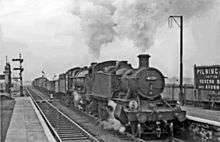
On 26 September 1881, the headings met and efforts transferred to finishing the tunnel and long deep cuttings at either end.[4] During October 1883, work was disrupted by more flooding from the Great Spring compounded by a spring tide a week later. Lambert and other divers managed to seal the works.[4] To alleviate water ingress problems a heading was driven at a gradient of 1 in 500 from the Sudbrook shaft to the fissure through which the Great Spring flowed. By diverting water into the heading, the walled-in section of the tunnel could be more easily drained and finished.[4] In 1885 the bed of a pool, known as the "Salmon Pool", on the English side of the tunnel broke through [9] the tunnel's continuous brickwork lining. It was expected that it would withstand the water pressure and so the drainage sluice valve on the side heading was closed and all but one of the pumps were taken from the site.[4] On 20 December, the pressure rose up to 395 kN per sq m and a number of bricks were pushed out of the lining. The sluice valve was opened gradually, allowing the pressure to subside but the long-term operation of additional pumping engines was required.[4] The Severn Railway Bridge spanning the Severn between Sharpness and Lydney opened to traffic during 1879.
On 22 October 1884 laying the double tracks in the tunnel started.[4] On 18 April 1885, the final brick was placed in the tunnel's lining. The tunnel was horse shoe-shaped in cross-section with a concave floor, its height was 6.1 meters above the rails with a maximum width of 7.9 meters. An enclosed 533mm high drainage channel, in the form of an upturned semi-circular tunnel, is built onto the tunnel invert, 1.4 meters below the rails. Around 76.4 million bricks were used in the tunnel's construction.[5] The brickwork is between 686mm and 914mm thick. At the deepest part of the tunnel, the roof is a maximum of 15.2 meters beneath the river bed.[4]
During mid-1885, the Severn Tunnel was completed and on 5 September 1885, a special train carrying company officials and VIPs, including Daniel Gooch, the chairman of the GWR, travelled through the tunnel.[4] The first goods train passed through on 9 January 1886. Regular services began when the permanent pumping systems were complete. On 17 November 1886, the tunnel works were inspected by Colonel F. H. Rich, the Government Inspector before it could be opened to regular traffic.[4] Colonel Rich approved the works and the tunnel was opened to regular goods trains during September 1886; the first passenger train followed on 1 December 1886, nearly 14 years since work started.[10][11]
Operations
At Severn Tunnel Junction station, the GWR built a marshalling yard, which distributed coal from the South Wales Valleys towards London and the Midlands, created mainline and local mixed-traffic freight from goods shipped in from the Midlands, the Southwest and along the Thames Valley into Wales and vice versa.
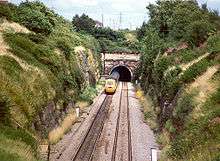
Because of the tunnel's access gradients, (eastwards, from Severn Tunnel Junction): 3 1⁄2 miles (5.6 km) at 1 in 90 (1.11%) down to the middle of the tunnel; a further 3 1⁄2 miles (5.6 km) at 1 in 100 (1%) up to Pilning; a short level then 3 1⁄2 miles (5.6 km) at 1 in 100 (1%) up to Patchway, throughout the steam era, assistance was required for heavy trains.[4] The locomotive shed at Severn Tunnel Junction (86E), had a number of pilot and banking locomotives to assist trains through the tunnel. Pilot locomotives usually worked eastwards and were detached at Pilning, and worked westwards piloting a second train back to the marshalling yard. Under British Rail the locomotives were usually GWR 5101 Class 2-6-2T locomotives, the bulk of which form the core preserved stock of that class.[12]
Fixed Cornish engines with Lancashire boilers used to pump water from the Great Spring and other sources of water were in use until the 1960s, when they were replaced by electrically powered pumps.[4] The pumps and control systems have since been replaced in the 1990s by Railtrack.[4] During the 1930s, the reliable fresh water supply from the Great Spring was a factor in favour of the selection of an adjacent site for the Royal Navy Propellant Factory, Caerwent. Water was also supplied to a paper mill at Sudbrook which has since been closed.[4]
The Severn Tunnel rail accident occurred on 7 July 1991. An InterCity 125 was struck from behind by a Class 155 Super-Sprinter. The accident investigation, while unable to reach a firm conclusion, indicated that the axle counters used for detecting train movements in the tunnel may have been accidentally reset.[13]
The Second Severn Crossing, built in the 1990s, crosses the tunnel on a "ground level bridge" on the English side, near the Salmon Pool. The bridge is supported so that no load is imposed on the tunnel. During that bridge's construction, the concrete cap above the tunnel in the Salmon Pool was renewed.

In 2002, two Class 121s were overhauled by LNWR for use as a Network Rail tunnel emergency train.[14] These were stabled to the west of Severn Tunnel Junction station but only used in training exercises.
Car transport
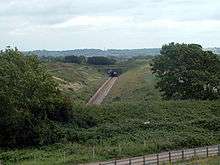
In 1924, the GWR started a car shuttle train service through the tunnel between Pilning and Severn Tunnel Junction as an alternative to the Aust Ferry, which operated an erratic timetable determined by the tides, or lengthy road journeys via Gloucester. The rail shuttle service continued until after World War II, but was made redundant by the opening of the Severn Bridge in 1966, leading to its discontinuation.[15]
Electrification
Severn Tunnel Junction | ||||||||||||||||||||||||||||||||||||||||||||||||||||||||||||||||||||||
|---|---|---|---|---|---|---|---|---|---|---|---|---|---|---|---|---|---|---|---|---|---|---|---|---|---|---|---|---|---|---|---|---|---|---|---|---|---|---|---|---|---|---|---|---|---|---|---|---|---|---|---|---|---|---|---|---|---|---|---|---|---|---|---|---|---|---|---|---|---|---|
| ||||||||||||||||||||||||||||||||||||||||||||||||||||||||||||||||||||||
In the 21st-century modernisation of the Great Western Main Line, the tunnel was prepared for electrification. The tunnel had good clearances and was relatively easy to electrify but the continuous seepage of water through its roof in some areas provided a challenge. The options of using conventional tunnel electrification equipment or a covered solid beam technology were considered[16] and it was decided to use the solid beam approach.[17] An aluminium conductor rail held in place using 7000 high-grade stainless steel fixtures, resistant to the hostile environment in the tunnel, was installed to hold an un-tensioned copper contact cable along the length of its roof.[18] Rigid rail is more robust, requires less maintenance, and is more compact than traditional overhead wires, and has been used in several other tunnels along the GWML.[17]
The tunnel was closed for six weeks from 12 September 2016 to install the overhead electrification equipment.[18] About 14 km of copper contact wires, 1,700 vertical drop tubes and 857 anchoring points at a rough cost of £10 million were installed in the tunnel which reopened to traffic on 22 October 2016.[19][17] Less than two years later, it was closed for three weeks after it was discovered that some of the overhead electrification equipment had started to corrode.[20] After investigation, the cause of the corrosion in the tunnel was identified as bacterial, and rectification measures were implemented including replacement of the copper contact wire by aluminium[21].
References
Citations
- Beaumont, Martin (2015). Sir John Hawkshaw 1811–1891. The Lancashire & Yorkshire Railway Society www.lyrs.org.uk. pp. 116–125. ISBN 978-0-9559467-7-6.
- "Severn Crossings". Institute of Civil Engineers. Retrieved 15 November 2019.
- "Broken down freight train removed from Severn Tunnel". BBC News. BBC. 6 August 2012. Archived from the original on 12 July 2016. Retrieved 6 August 2012.
- "Severn Tunnel." Archived 2 July 2018 at the Wayback Machine engineering-timelines.com, Retrieved: 2 July 2018.
- "Preparing for Severn Tunnel electrification." Archived 2 July 2018 at the Wayback Machine Rail Engineer, 2 June 2016.
- "Great Western Mainline Electrification Project. Environmental Statement. Volume 2" (PDF). Network Rail. Network Rail. February 2013. Archived (PDF) from the original on 4 March 2016. Retrieved 27 July 2016.
- Davis, RH (1955). Deep Diving and Submarine Operations (6th ed.). Tolworth, Surbiton, Surrey: Siebe Gorman & Company Ltd. p. 693.
- Quick, D. (1970). "A History of Closed Circuit Oxygen Underwater Breathing Apparatus". Royal Australian Navy, School of Underwater Medicine. RANSUM-1-70. Archived from the original on 9 May 2008. Retrieved 3 March 2009.
- "Severn Tunnel". Track Topics, A GWR Book of Railway Engineering. Great Western Railway. 1971 [First published 1935]. ISBN 0-85059-080-9.
- Wikisource:The Severn Tunnel/Chapter 11
- Walker, Thomas A. (27 June 2013). "The Severn Tunnel: Its Construction and Difficulties, 1872–1887". Cambridge University Press. Retrieved 2 February 2015.
- "4150 history." Archived 9 May 2015 at the Wayback Machine 4150.org.uk, Retrieved: 2 July 2018.
- Seymour, R.J. Railway Accident in the Severn Tunnel. H.M. Railway Inspectorate. Archived from the original on 29 June 2013. Retrieved 2 July 2018.
- Severn Tunnel Bubble Cars due in April Rail issue 427 23 January 2002 page 61
- OS Nock (1967). History of the Great Western Railway: 1923–48 v. 3. London: Ian Allan Ltd. p. 42. ISBN 0-7110-0304-1.
- Peter Dearman (28 April 2011). "Electrification: delivering the transformation". Global Rail News. Archived from the original on 10 March 2014. Retrieved 10 March 2014.
- Carr, Colin. "Severn Tunnel Electrification - Planning logistics and interfaces." Archived 2 July 2018 at the Wayback Machine railengineer.uk, 13 December 2016.
- "Severn Tunnel Electrification". Modern Railways. Vol. 73 no. 815. Railway Study Association. August 2016. p. 70.
- "Severn Tunnel reopens after £10m electrification work". BBC News. Archived from the original on 23 October 2016. Retrieved 22 October 2016.
- Williamson, David (2 July 2018). "Minister admits new Severn Tunnel electrification equipment is rusting". WalesOnline. Archived from the original on 11 July 2018. Retrieved 11 July 2018.
- Stanton, Peter (7 February 2020). "Electric Trains Arrive in Wales, though not for the first time". Rail Engineer. Retrieved 20 May 2020.
Bibliography
- The Severn Tunnel: Its Construction and Difficulties (1872–1887) by Thomas A. Walker ISBN 1-85026-014-1 (1st edition 1888) reprinted edition 2004, Nonsuch Publishing Ltd, Stroud, England ISBN 1-84588-000-5. Reissued in 2013 (from fresh photographs of the 1890 second edition) by Cambridge University Press, ISBN 978-1-108-06340-1. (Walker was the contractor entrusted by the chief GWR engineer Sir John Hawkshaw with rescuing and completing the tunnel after the 1879 flooding)
- Railway Tales of the Unexpected by K Westcott-Jones ISBN 0-946537-73-9, 1992, Atlantic Transport Publishers.
Further reading
- Lewis, Deryck (November 1986). "100 Not Out". Rail Enthusiast. No. 62. EMAP National Publications. pp. 26–28. ISSN 0262-561X. OCLC 49957965.
External links
| Wikimedia Commons has media related to Severn Tunnel. |
- History of the tunnel from the Great Western Archive
- Building the Severn Tunnel, how divers tried to seal the Great Spring